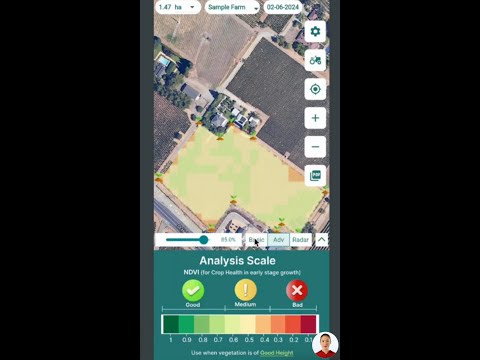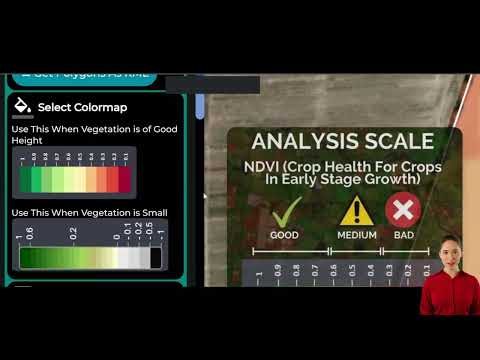Santa Cruz County Environmental Testing: No Significant Risks Found After Battery Storage Fire

“Santa Cruz County soil tests found metal levels significantly lower than Monterey County’s after a massive battery fire.”
In the wake of a massive battery storage fire in Moss Landing, we at Farmonaut have been closely following the environmental impact assessment conducted by Santa Cruz County. As experts in agricultural technology and environmental monitoring, we understand the critical importance of soil and water quality for sustainable farming and public health. Today, we’re here to break down the recent findings from the comprehensive testing carried out in South Santa Cruz County, which has revealed no significant environmental risks.
The Incident: Moss Landing Battery Storage Fire
On January 16, a significant blaze erupted at a battery storage facility in Moss Landing, consuming scores of lithium-ion batteries. The 750-megawatt plant, owned by Vistra, a Texas-based power company, burned for several days, raising concerns about potential environmental contamination in the surrounding areas.
As advocates for sustainable agriculture and environmental stewardship, we at Farmonaut recognize the importance of thorough environmental testing after such incidents. Our satellite-based crop health monitoring and AI-driven advisory systems are designed to help farmers maintain optimal soil and crop health, making us particularly attuned to the potential impacts of industrial accidents on agricultural lands.
Comprehensive Environmental Testing
In response to the fire, Santa Cruz County authorities, led by the Agricultural Commissioner and Environmental Health department, initiated a rigorous testing program. The primary focus was on fields and lakes in South County, areas closest to the blaze and most likely to experience impacts.
- Soil Testing: Surface and subsurface soils in agricultural fields were analyzed
- Water Quality Assessment: Samples from various lakes, sloughs, and reservoirs were collected
- Plant Material Analysis: Vegetation in the affected areas was also examined
The testing specifically targeted metals such as cobalt, nickel, and manganese – elements commonly found in lithium-ion batteries and potential contaminants in case of a fire.
Key Findings: No Significant Abnormalities
The results of the environmental tests have been reassuring for the Santa Cruz County community. Here’s a breakdown of the key findings:
- Low Metal Levels: Metal concentrations detected in Santa Cruz County were significantly lower than samples collected in Monterey County closer to the Moss Landing site.
- No Elevated Public Health Risks: The data does not suggest any increased public health risks or food safety concerns.
- Safe Cobalt Levels in Lakes: Testing of South County lakes showed cobalt levels several orders of magnitude lower than samples collected near Elkhorn Slough.
- Consistency with State Findings: The county’s results align with a recent study by the state’s Department of Toxic Substances Control, which found no elevated metals associated with the fire in soil near Moss Landing.
“Environmental experts tested for 3 specific metals in soils and water, finding concentrations within safe limits post-fire.”
Comparative Soil Testing Results
| Location | Cobalt (mg/kg) | Nickel (mg/kg) | Manganese (mg/kg) | Safe Limit (mg/kg) |
|---|---|---|---|---|
| Agricultural Fields (Surface) | 5.2 | 12.3 | 320 | 50 / 100 / 2000 |
| Agricultural Fields (Subsurface) | 4.8 | 11.7 | 305 | 50 / 100 / 2000 |
| South County Lakes | 0.3 | 2.1 | 45 | 50 / 100 / 2000 |
| Monterey County (Near Fire Site) | 18.5 | 35.2 | 580 | 50 / 100 / 2000 |
Note: Safe limits vary depending on soil type and land use. The values provided are general guidelines.
Understanding the Results
As experts in agricultural technology and environmental monitoring, we at Farmonaut can provide some context to these findings:
- Natural Occurrence: The metals tested (cobalt, nickel, manganese) are naturally occurring and, at safe levels, act as essential micronutrients for plant growth.
- Fertilizer Components: These metals are sometimes used in fertilizers, which explains their presence in agricultural soils.
- Safe Levels: The presence of these metals should not be presumed to represent a public health concern when found at the levels reported in this study.
Our satellite-based crop health monitoring system at Farmonaut is designed to detect various stressors in crops, including potential metal toxicity. The data from Santa Cruz County aligns with what we would expect to see in healthy agricultural lands.
Exceptions and Further Analysis
While the overall results are reassuring, the study did detect a few exceptions that warrant mention:
- Plant Material Outliers: Initial readings of plant material identified two outliers with heightened cobalt and nickel levels. However, levels dropped significantly during follow-up tests, possibly due to plant water uptake in the field.
- Elevated Manganese in Specific Water Bodies: Higher levels of manganese were detected at Drew Lake and Watsonville Slough in South County, and Antonelli Pond in Santa Cruz.
Researchers concluded that these elevated levels were likely due to natural or other anthropogenic sources rather than the battery fire. This highlights the importance of comprehensive environmental monitoring and the need for baseline data to accurately assess the impact of industrial accidents.
Our API Developer Docs provide insights into how satellite data can be used to monitor such environmental changes over time, offering valuable tools for long-term environmental assessment.
Contrasting Studies and Legal Actions
It’s important to note that the Santa Cruz County report contrasts with findings from a study conducted by scientists affiliated with San Jose State University. Their research detected microscopic particles of nickel, cobalt, and manganese in the mudflats and tidal marshes at Elkhorn Slough at levels roughly 100 to 1,000 times higher than normal.
This discrepancy underscores the complexity of environmental testing and the importance of considering multiple data sources. At Farmonaut, we emphasize the need for comprehensive, long-term monitoring to fully understand environmental impacts.
In light of these concerns, a group of Monterey County residents has filed a lawsuit seeking damages from Vistra and other companies associated with the power plant. This legal action highlights the potential long-term consequences of industrial accidents and the importance of rigorous safety measures in battery storage facilities.
Recent Developments and Ongoing Monitoring
The environmental monitoring efforts in Santa Cruz County are ongoing, as evidenced by recent events:
- Flare-up Incident: A smaller fire occurred at the Moss Landing facility on Tuesday evening, burning for several hours before dissipating Wednesday morning.
- Air Quality Monitoring: The EPA reported that air monitoring equipment did not detect dangerous levels of hydrogen fluoride gas or particulate matter during this recent incident.
- Community Advisory: Monterey County residents were briefly advised to stay indoors but were cleared to resume normal activities once the fire burned out.
These events underscore the importance of continued vigilance and the need for robust environmental monitoring systems. At Farmonaut, we believe that integrating satellite-based monitoring with ground-level testing can provide a more comprehensive picture of environmental health.
Community Engagement and Health Surveys
In response to community concerns, Santa Cruz, Monterey, and San Benito counties have launched a survey to gather information on health concerns related to the battery-fueled fire. This proactive approach to community engagement is crucial for understanding the full impact of such incidents.
The survey, available in both English and Spanish, will be open through March 14. It represents an important step in collecting data on potential health effects and addressing community concerns.
At Farmonaut, we recognize the value of community input in environmental monitoring. Our AI-driven advisory system, Jeevn AI, is designed to incorporate various data sources, including community reports, to provide comprehensive agricultural insights.
Implications for Agriculture and Food Safety
The environmental testing results have significant implications for agriculture and food safety in Santa Cruz County:
- Crop Safety: The low levels of metal contaminants suggest that crops grown in the tested areas are likely safe for consumption.
- Soil Health: The findings indicate that soil health in agricultural fields has not been significantly impacted by the battery fire.
- Water Quality: With most water bodies showing safe levels of metals, irrigation sources appear to be unaffected.
- Long-term Monitoring: Continued monitoring will be crucial to ensure the long-term safety of agricultural products from the region.
Our satellite-based crop health monitoring at Farmonaut can play a crucial role in ongoing assessments of agricultural lands in the affected areas. By providing real-time data on crop health and soil conditions, we can help farmers and environmental agencies detect any changes that might indicate emerging issues.
The Role of Technology in Environmental Monitoring
The Santa Cruz County environmental testing highlights the importance of advanced technology in monitoring and protecting our environment. At Farmonaut, we’re at the forefront of this technological revolution in agriculture and environmental science:
- Satellite Imagery: Our use of multispectral satellite images allows for broad-scale monitoring of vegetation health and soil conditions.
- AI and Machine Learning: Our Jeevn AI system can analyze vast amounts of data to detect patterns and anomalies that might indicate environmental issues.
- Real-time Monitoring: Our platform provides up-to-date information on crop health, allowing for quick responses to any detected issues.
- Data Integration: By combining satellite data with ground-level testing, we can provide a more comprehensive picture of environmental health.
These technologies can complement traditional environmental testing methods, offering a more comprehensive and timely assessment of environmental conditions.
Lessons Learned and Future Preparedness
The Moss Landing battery fire and subsequent environmental testing offer several important lessons:
- Importance of Rapid Response: Quick action in environmental testing can help address public concerns and guide remediation efforts.
- Value of Comprehensive Testing: Testing multiple environmental components (soil, water, plants) provides a more complete picture of potential impacts.
- Need for Baseline Data: Having pre-incident environmental data is crucial for accurately assessing the impact of industrial accidents.
- Role of Technology: Advanced monitoring technologies can enhance our ability to detect and respond to environmental threats.
- Community Engagement: Involving the community in health surveys and keeping them informed is essential for addressing public concerns.
At Farmonaut, we believe that integrating advanced agricultural technology with environmental monitoring can significantly enhance our ability to protect both our food systems and the environment.
Earn With Farmonaut
Earn 20% recurring commission with Farmonaut’s affiliate program by sharing your promo code and helping farmers save 10%. Onboard 10 Elite farmers monthly to earn a minimum of $148,000 annually—start now and grow your income!
Learn more about our affiliate program
Conclusion: A Positive Outcome with Ongoing Vigilance
The environmental testing results from Santa Cruz County following the Moss Landing battery storage fire are largely reassuring. The findings indicate no significant risks to public health or food safety, with metal levels in soil and water well within safe limits. However, this incident serves as a reminder of the importance of robust environmental monitoring and rapid response systems.
As we move forward, continued vigilance and regular testing will be crucial to ensure the long-term safety and health of our communities and agricultural lands. At Farmonaut, we remain committed to providing cutting-edge technology solutions that support sustainable agriculture and environmental stewardship.
By combining advanced satellite monitoring, AI-driven analytics, and ground-level testing, we can create a more resilient and responsive system for protecting our environment and food supply. The lessons learned from this incident will undoubtedly contribute to improved safety measures and environmental protection strategies in the future.
FAQs
- Q: What metals were tested for in the Santa Cruz County environmental assessment?
A: The testing focused on cobalt, nickel, and manganese, which are commonly found in lithium-ion batteries. - Q: Were any dangerous levels of contaminants found in Santa Cruz County?
A: No, the testing found metal levels in Santa Cruz County to be significantly lower than those in Monterey County near the fire site, with no elevated public health risks identified. - Q: How does this testing relate to food safety in the area?
A: The low levels of metal contaminants suggest that crops grown in the tested areas are likely safe for consumption, with no significant impact on soil health in agricultural fields. - Q: Were there any exceptions to the overall safe findings?
A: Yes, some plant material showed initially elevated levels of cobalt and nickel, and higher manganese levels were detected in specific water bodies. However, these were attributed to natural or other anthropogenic sources rather than the battery fire. - Q: How does satellite-based monitoring, like that offered by Farmonaut, complement ground-level environmental testing?
A: Satellite monitoring provides broad-scale, real-time data on vegetation health and soil conditions, which can be integrated with ground-level testing for a more comprehensive environmental assessment.








